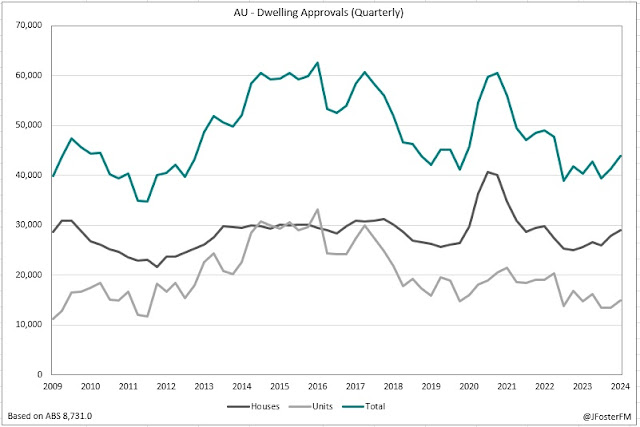Australian dwelling approvals lifted by 4.4% in September, coming in topside on consensus (2.1%) and rebounding from a 3.9% decline in August (revised from -6.1%). House approvals (2.4%) continued to defy the headwinds from higher interest rates, pressing ahead for the 8th month on end to reach their highest level since August 2022. An 8.4% rise from the volatile higher-density segment also contributed to the uplift in approvals.
Momentum in dwelling approvals continues to extend on strength in the house (or detached) segment. Nationally, approvals lifted by 4.4% in September (14.8k), rising by 6.3% across the quarter to their highest quarterly total (43.9k) since Q4 2022. House approvals advanced 2.4% month-on-month to 9.9k (16.3%yr), levels near the peaks of earlier cycles. In the most recent quarter, house approvals lifted by 4.1% to 29k, a high since Q2 2022.
In the higher-density segment, approvals increased by 8.4% in September (5k), continuing their volatile month-to-month profile of recent times. For Q3, unit approvals lifted by 10.7% to 14.9k, a level just off cycle lows.
A couple of key factors are supporting the uptrend in house approvals, despite higher interest rates. Firstly, population growth is driving very strong demand for housing; and secondly, the rate of housing completions has been outpacing new commencements for some time, driving more approvals.
Strength in house approvals has been broadly based across the nation, though New South Wales has been a notable exception where approvals are down 20.3%yr. The momentum in house approvals at the national level is being driven by Western Australia, the state seeing a 60.2% rise over the past 12 months. South Australia (29.8%) and Queensland (23.8%) have also contributed strongly.
The 10.7% quarterly rise in higher-density approvals looks to have been driven by the high-rise category, particularly in Melbourne and Brisbane. Low-rise units appear to have played a lesser role, while townhouse developments edged lower in Q3.






